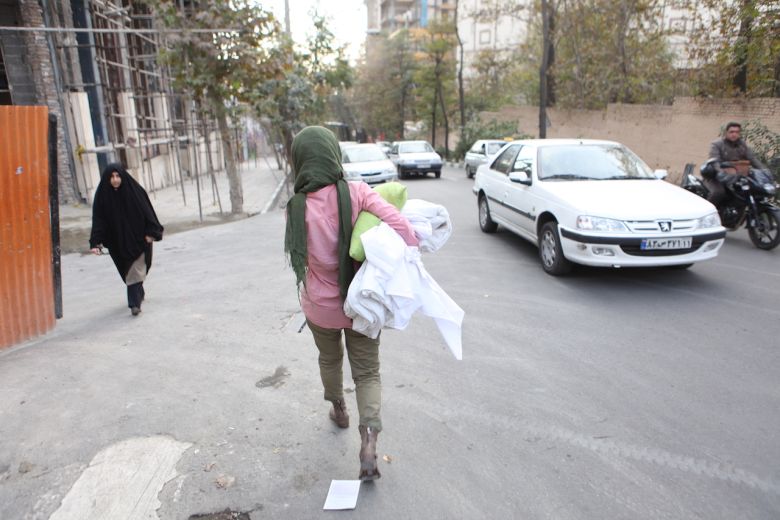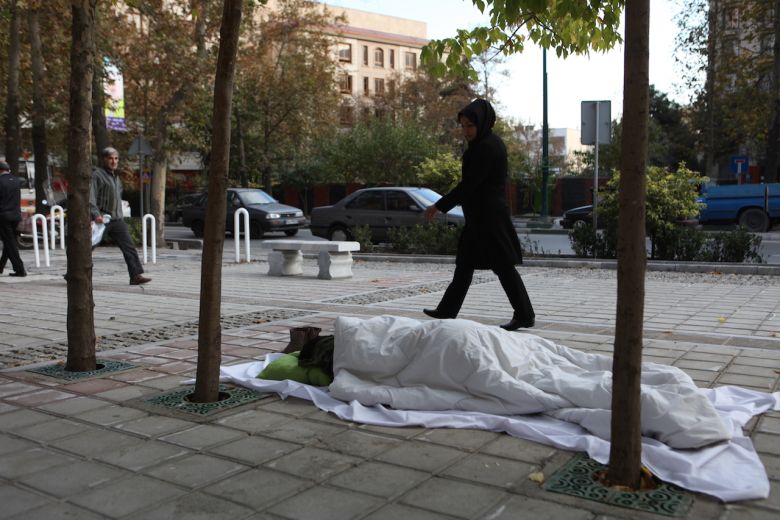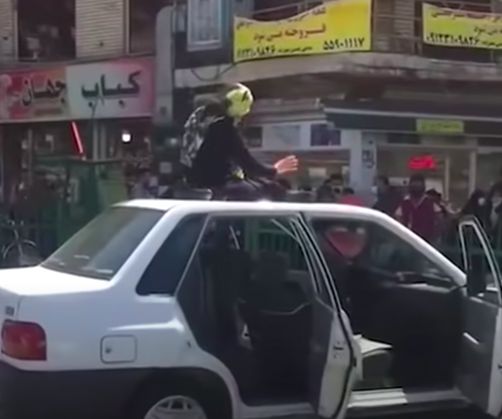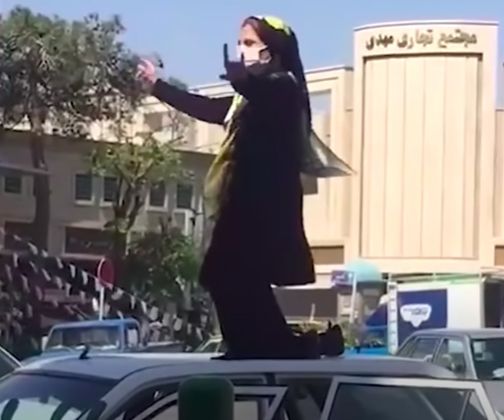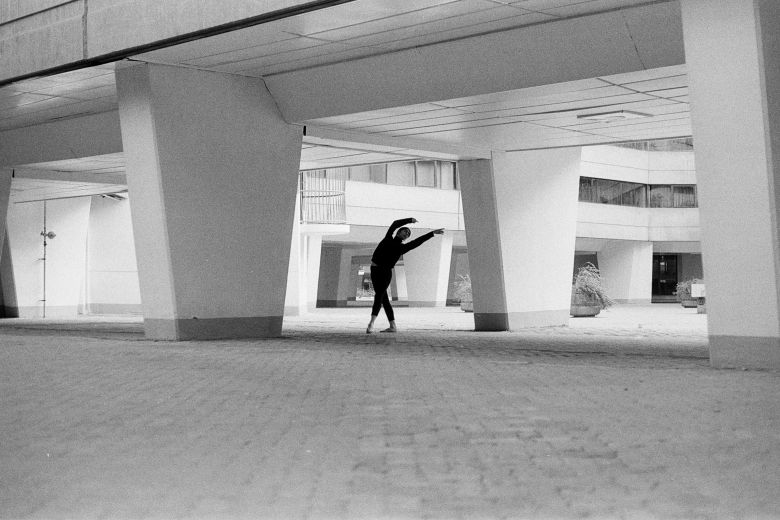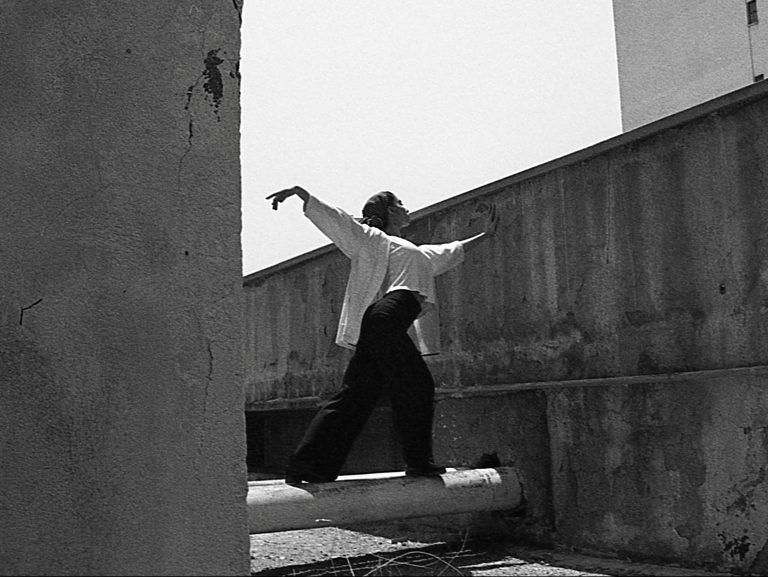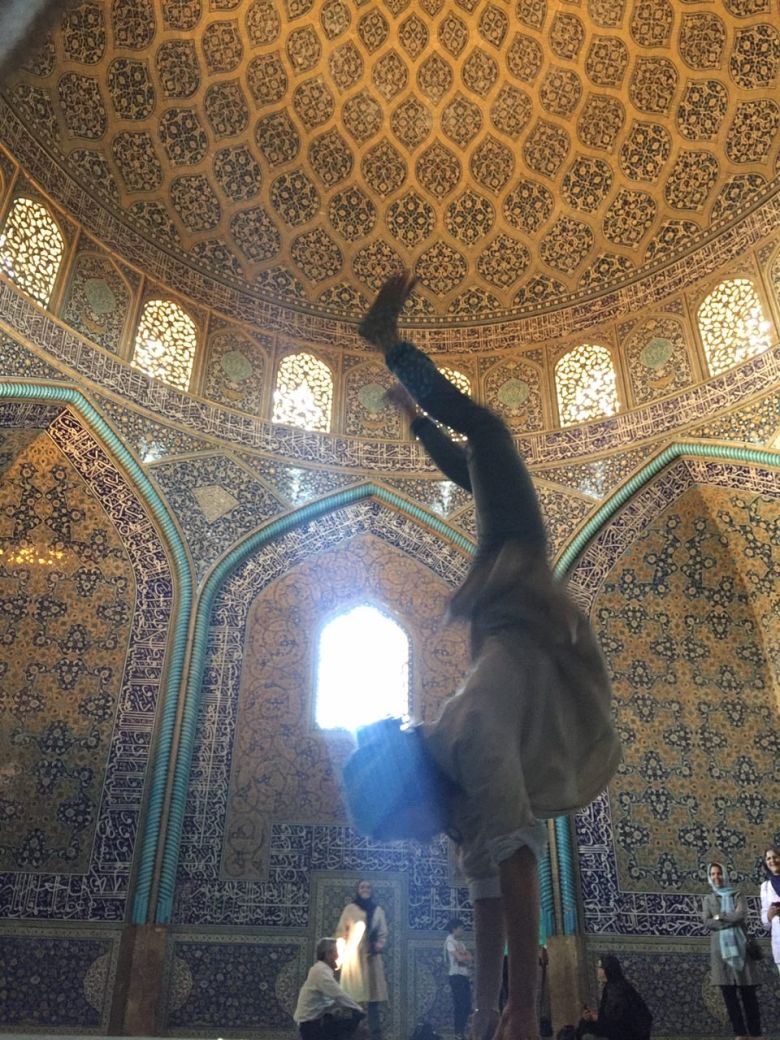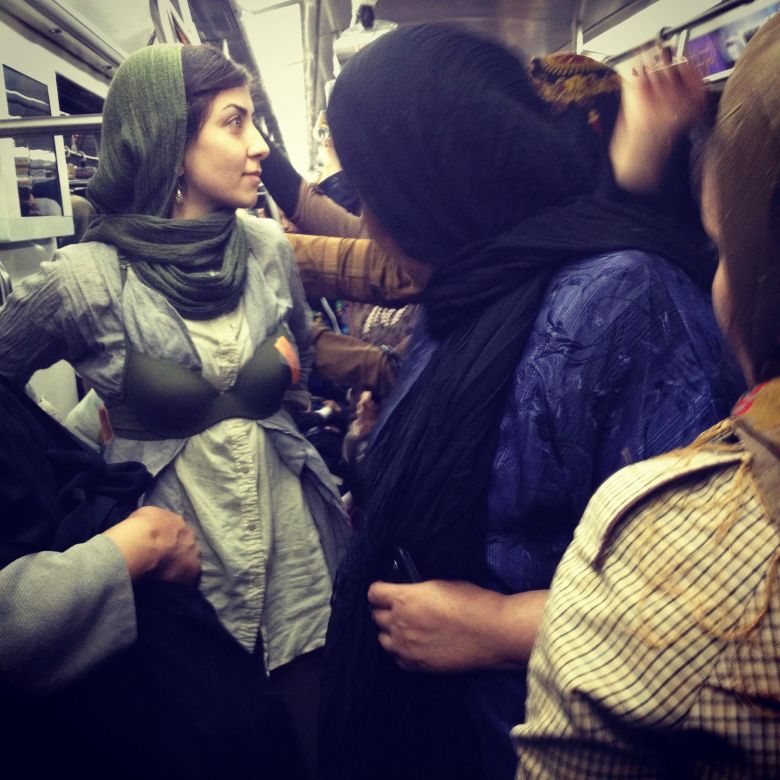This collage brings together text excerpts and images from performance artist, researcher, and writer Saba Zavarei’s wide-ranging practice of exploring alternative urban and public spaces that women in Iran and in exile transgress in their everyday lives.
[…] It’s a very ordinary day in a very ordinary corner of Tehran. Pairs and pairs of eyes staring ahead as they pass by. The city traffic rumbles and roars. I’m holding my sheet, pillow and duvet in my arms, wandering, looking around for somewhere to take a nap. There. I open the bedsheet into the air to free it of its wrinkles. The air swells beneath it. Gently, slowly, it begins to land. My gaze is frozen there, on the edge of the sheet as it touches the ground. And now all heads turn towards it and cars slow down to check out what is going on. As if entering someone’s house, I take off my shoes and place them neatly next to the spread sheet. Its edge becomes the threshold of home, somewhere I trust, a place I seek comfort in. It becomes my space; my bed. […]
The ephemeral nature of the performances makes it impossible for the authorities to track and trace every single action. Vanishing and disappearing, each performance carves a new pattern in the space it occupies. The infinite number of collages that happen in everyday life, and that challenge the normative geography of places, begin to make cracks in hegemonic power. In the multiplication and proliferation of the performances, the cracks extend and the seemingly solid structures that the authorities try to promote become the most fragile, most inaccurate representation of space. The performances multiply the space, creating new Tehrans in which marginalized and suppressed bodies challenge the power balance that exists within it, creating space for them. Tehrans that are being performed differently to their formal, permitted representations. Tehrans that are concealed from the eyes so that the homogeneous picture created by the authorities isn’t disturbed. Hope is the performance of another place, a new collage in the midst of the layers of a city, performed by out-of-place bodies. […]
Performance Research (Vol. 21, 2016), 79-82.
She dances on a car roof. The doors are left open and loud music is playing; instrumental, with no words. She sways gently then pauses to fix her mandatory hijab on her head, tying the scarf behind her neck. Limited by the edges of the car roof, she slowly swings her body. Behind her is a big urban roundabout. A high-rise shopping mall on the other side of the square visually echoes her upright body. An old woman smiles as she passes by. A few other people pay no attention. In another video, captured from another angle, a crowd of around twenty people have gathered on the pavement. Facing them, she calmly taps her feet, as if performing on a stage. Her audience makes indistinct comments. She moves in silence. There is no sign or trace to suggest what her motive is, if any. Nothing to help her confused audience interpret what they witness, other than a dancing woman on a car roof. The music stops. She bows. This is the end of her performance. […]
The contest is over the meaning of space, and what is and what is not allowed in particular places. As the geographer Doreen Massey writes, “[t]he identities of place are always unfixed, contested and multiple. […] Places viewed this way are open and porous,” thus, the transgressive performances that challenge the identity of place, could be read as attempts to de-stabilize “the meaning of particular envelopes of space-time”.1 These performance interventions disrupt the hegemonic meaning of place, reinterpreting them through lived experiences. If we look into the formal art institutions in Iran today, these artistic practices go largely unnoticed by the general public, and have little bearing on the actual politics of space and bodies in Iran. I have argued that, in order to understand socially-engaged creative and artistic practice in Iran that intervenes into the patriarchal order, we need to turn to practices taking place in everyday life, and the transgressive acts through which artists reclaim the spaces of everyday life. This is where the art of presence as Bayat terms it, meets the artistic practices of those who have shunned galleries and stages. These art works have no chance of being shown in the formal art scene inside Iran. Therefore, they either remain in the artist’s archive, on social media, or with higher risk, they travel outside to be showcased in international art scenes away from the watchful eyes of authorities. In the videos I have described, bodies out-of-place, actually meet in the street. Here, both professional artists and non-artists apply the same tactics to reclaim their right to the city.
For over four decades, the Islamic Republic has dictated an aesthetics that excludes female bodies from certain places, and delimits their performances to particular gestures and acts of “modesty”. The state ceaselessly encourages women to be “perfect wives and mothers”, while diminishing social roles they take. Furthermore, it controls the image to merely represent them as docile bodies. Women in official representations do not laugh loud, they often do not run or jump around or climb trees, the state media does not even show women’s sport matches. In the official pictures, women always leave bed or bathroom with complete hijab, which has turned into a joke, but behind this bitter joke, is a brutal removal of the everyday activities that one needs to freely express and experience. Ultimately, the attempt is to internalize fear, shame and anxiety for taking up space and having strong social presence. The state representation of women has removed dancing, singing, and many other everyday performances as well as art forms. Rancière defines aesthetics as “the distribution of the sensible,” an order of things that is normalized by hegemonic power, “the system of self-evident facts of sense perception that simultaneously discloses the existence of something in common and the delimitations that define the respective parts and positions within it.”2 He writes that artistic practices are “ways of doing and making” that intervene in the general distribution of ways of doing and making as well as in the relationships they maintain to modes of being and forms of visibility.3 The disobedient body in the cases I have analyzed here, interrupts the hegemonic aesthetics of public space in Iran, and opens it up to new meanings and interpretations. It challenges what is dictated or perceived as normal, and exposes the discrimination and oppression that are embedded in the aesthetic protocols of the state. The insubordinate dancer disrupts the hegemonic order and the documents of these performances, scattered on the internet, or hidden away on personal hard drives, configure an alternative aesthetic, that defies tyranny and embraces the possibility of a kind of emancipation. […]
Field Journal, Issue 21 (Spring 2022) .
The audience is gathered in Fordham Park, in South East London. I ask for participants to join me in reading out loud four different texts that I have printed out. Four people come forward, each taking on a piece of the performance text. I ask them, when it is their turn, to choose a plinth on which to climb in order to read the text to the audience, each time selecting a different plinth. We lead the audience through the park and as we perform the texts, each height turns into a plinth. At the same time, I ask the audience to go through a pdf file made accessible through the website with the images they are invited to look at while listening to us. […]
One young woman stands on the utility box. She is highly visible there. Impossible to not notice. She is playfully waving her scarf that is tied on a piece of stick, instead of wearing it. A forbidden form, in an unacceptable outfit, standing right off one of the busiest streets of the capital. People come and go. She shocks them. She is an impossible being. Yet real, calm and composed. […]
She is there to perform what she is rather than what she wants. She is the manifestation of what all progressive and reformist representatives have promised to her and failed to provide. It’s in her loneliness that she finds unity with others. Others who like her, are deprived of any collective act that now what they all share is this: a body, that must perform what she wants. Others join in. Others are inspired by not asking what you want, but being it. It is in this silence that the behaviour of one body, becomes the embodiment of a whole people’s desire: the agency itself rather than calling for it.
She performs the change, the alternative, the dream, and the society of spectacles on the other side of the abyss, far away from the plinth, remains speechless. […]
Konesh: Scale (spring 2019).
[…] Rojin has been a street musician and singer in Tehran for six years. In her many performances around the city, accompanied by her brother on the guitar, she has spotted places that are ‘good for public performance’, mainly based on the type of audience and lack of police patrols. Despite being experienced and cautious, she has encountered problems with the police. However, she thought to herself:
if I continued singing like this for a few years, it would be normalized, as fast as it is now. To me it [singing in public] wasn’t a conscious act of protest or a revolutionary statement. But to people who were watching, it was. There were women who took off their hijab. It inspired them. Compared to the times my brother sang, people gave us more money when I was singing. They wanted to show their support… (Rojin Fahimi, interview)
While the state encourages people to spy on each other, the mere act of watching a woman singing, without meddling or reporting her, somehow constitutes complicity in that transgression. […]
These collaborative interventions and reflections of subjective experiences show how transgressive performances of everyday life can open up spaces for alternative behaviours in Iran today — if we go beyond the reductionist dichotomy of private–public spatial categories and focus on the body as an agent of change. I argue for a performative reading of the interaction of body and space, where tactics stem from agency and subjectivity rather than from two sets of already existing spatial orders. By returning to the body as the main agent of interaction and occupation, and performance as the mode of understanding, I argue for the acknowledgement of bodies that subvert, gain control, regain their agency and perform their subjectivity. Consequently, this leads to performances out of place, where bodies trespass in an already existing normative geography, and reclaiming public spaces by creating alternative meanings.
It is, however, the ephemerality of the performance that is used as a tactic: temporality wins over spatiality. To circumvent obstacles in space, performances occupy locations for a limited amount of time. But these ephemeral acts are repeated through their documentation, which lends testimony to the ephemeral. As fleeting as these moments may be, they disrupt the hegemonic order and shape alternative realities. Through these tactics, women — among other disenfranchised groups — are creating emancipatory spaces and alternative performances in Iran today. They create ever-expanding networks of political subjectivities and challenge those oppressive taboos and norms that wish to assign women to their ‘place’. But their bodies out-of-place occupy khiaban with their songs of disobedience.
Performance Research. A Journal of the Performing Arts, Volume 26 (2021), 122-127.
Saba Zavarei, “A Song of Disobedience,” in mohit.art NOTES #8 (December 2023); published on www.mohit.art, November 24, 2023.
